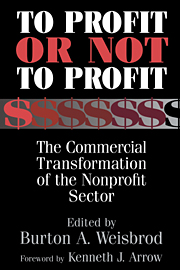Book contents
- Frontmatter
- Contents
- List of contributors
- Foreword by Kenneth J. Arrow
- Preface
- 1 The nonprofit mission and its financing: Growing links between nonprofits and the rest of the economy
- Part I Basic issues and perspective
- Part II Industry studies
- 8 Commercialism in nonprofit hospitals
- 9 Universities as creators and retailers of intellectual property: Life-sciences research and commercial development
- 10 Commercialism in nonprofit social service associations: Its character, significance, and rationale
- 11 Zoos and aquariums
- 12 Commerce and the muse: Are art museums becoming commercial?
- 13 The funding perils of the Corporation for Public Broadcasting
- Part III Overview, conclusions, and public-policy issues
- Appendix: IRS Forms 990 and 990-T for nonprofit organizations
- References
- Index
12 - Commerce and the muse: Are art museums becoming commercial?
Published online by Cambridge University Press: 30 November 2009
- Frontmatter
- Contents
- List of contributors
- Foreword by Kenneth J. Arrow
- Preface
- 1 The nonprofit mission and its financing: Growing links between nonprofits and the rest of the economy
- Part I Basic issues and perspective
- Part II Industry studies
- 8 Commercialism in nonprofit hospitals
- 9 Universities as creators and retailers of intellectual property: Life-sciences research and commercial development
- 10 Commercialism in nonprofit social service associations: Its character, significance, and rationale
- 11 Zoos and aquariums
- 12 Commerce and the muse: Are art museums becoming commercial?
- 13 The funding perils of the Corporation for Public Broadcasting
- Part III Overview, conclusions, and public-policy issues
- Appendix: IRS Forms 990 and 990-T for nonprofit organizations
- References
- Index
Summary
Introduction
In this chapter, we examine the commercialization of art museums by looking at trends and patterns of revenue and expenditures as well as other financial indicators over time. Commercialization involves greater reliance on earned income relative to other forms of revenue, such as donations and government grants. In the case of museums, earned income includes fees, sales, and charges that are related or unrelated to the charitable purpose of the organization. We first explore possible reasons for, and characteristic elements of, commercialization, and then look for patterns that might help explain whether (and if so, why) art museums have become more commercial over time. For the main part of this analysis, we make use of the tax returns (Forms 990) of the largest U.S. museums at five different points in time between 1982 and 1992.
Over the past three decades the museum field has undergone major changes, as museums slowly transformed from secluded temples of culture to more popular institutions with considerable public appeal (d'Harnoncourt et al. 1991, 54–5). Beginning in the 1960s, both the number of museums and the number of visitors to them increased considerably. Attendance at art museums rose from twenty-two million in 1962 to forty-two million in 1975 to seventy million in 1986 and to over seventy-five million in 1988 (Heilbrun and Gray 1993, 170). The number of art museums expanded as well. Indeed, one out of two American art museums was founded after 1970: 13 percent were founded in the 1980s, and 37 percent in the 1970s, whereas 18 percent were created during the 1960s, and only 31 percent of all art museums were founded before that decade (AAM 1992, 64).
- Type
- Chapter
- Information
- To Profit or Not to ProfitThe Commercial Transformation of the Nonprofit Sector, pp. 233 - 248Publisher: Cambridge University PressPrint publication year: 1998
- 14
- Cited by



